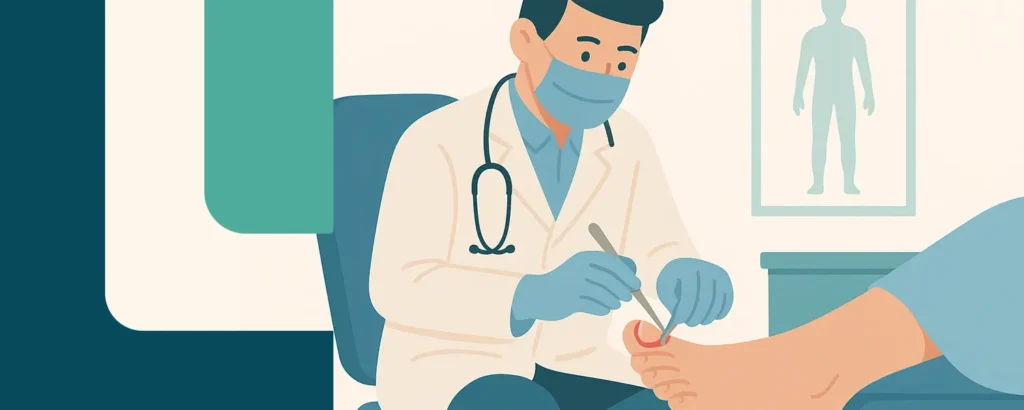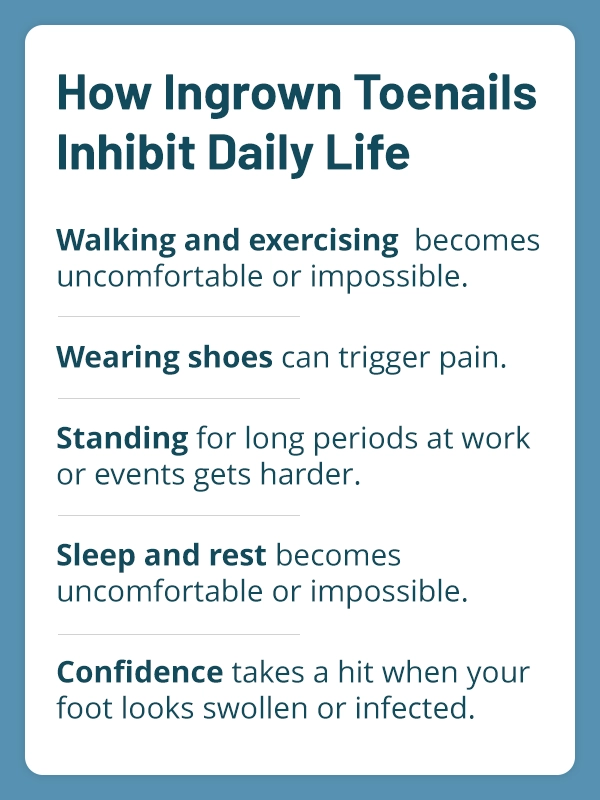Everything You Need to Know About Ingrown Toenails — and How to Get Relief

Let’s face it: there’s nothing small about the pain of ingrown toenails. What starts as a little tenderness in your toe can quickly turn into a painful, red, and even infected problem that impacts your day-to-day life.
Whether you’re limping through your workouts, skipping your favorite shoes, or just trying to get through the workday without wincing, ingrown toenails can be a serious hassle.
The good news? You’re not alone. Ingrown toenails are incredibly common, and there are proven ways to treat them and prevent them from coming back. At Upperline Health, our podiatrists specialize in helping patients move past the pain and get back on their feet—comfortably.
Let’s break down everything you need to know about this pesky condition.
What Is an Ingrown Toenail?
An ingrown toenail happens when the edge of your toenail grows into the surrounding skin instead of over it. The result is inflammation, pain, swelling, and sometimes infection. It most commonly affects the big toe, but any toe can be impacted.
The American College of Foot and Ankle Surgeons estimates that ingrown toenails are one of the most frequent foot problems in the U.S., affecting nearly 20% of people who visit a podiatrist (ACFAS, 2023).
How Common are Ingrown Toenails?
More common than you might think. According to a study published in the Journal of the American Podiatric Medical Association, ingrown toenails account for a significant portion of foot complaints among both adolescents and adults (Mozena et al., 2012).
The Cleveland Clinic reports that nearly 3 million cases of ingrown toenails are treated annually in the United States alone.
So if you’re dealing with one, you’re definitely not alone.
What are the Complications of an Ingrown Toenail?
While many people try to tough it out or treat it at home, untreated ingrown toenails can lead to bigger issues, especially for people with diabetes or poor circulation.
Here are some complications that can arise when ingrown toenails are not managed:
- Infection: Bacteria can enter the broken skin, leading to pus, increased redness, and even fever.
- Abscesses: Painful, fluid-filled sacs may form and require surgical drainage.
- Tissue overgrowth: The skin may begin to grow over the nail, making treatment more difficult.
- Chronic pain and mobility issues: Walking and standing become more painful, limiting your activity level.
In extreme cases, especially for people with diabetes, an untreated ingrown toenail can lead to serious infections that risk the health of the entire foot.
How Do Ingrown Toenails Inhibit Daily Life?
It might just be a toe, but it affects everything. Here’s how an ingrown toenail can slow you down:
- Walking and exercising becomes uncomfortable or impossible.
- Wearing shoes (especially anything snug or closed-toe) can trigger pain.
- Standing for long periods at work or events gets harder.
- Sleep and rest are interrupted if the pain flares up at night.
- Confidence takes a hit when your foot looks swollen or infected.
When something as simple as putting on socks hurts, it’s time to take action. Don’t wait. Call to schedule an appointment with a podiatrist today.
What are the Risk Factors if Left Untreated?
If you ignore an ingrown toenail, you risk more than just discomfort. Here’s what can happen if it goes untreated:
Worsening infection
Bacteria can spread deeper into the skin and bone, making the infection harder to treat.
Permanent nail deformity
Chronic pressure and inflammation can cause the nail to grow abnormally or become thickened and discolored.
Nerve damage (in diabetics or those with neuropathy)
Ongoing irritation and infection may further damage already-compromised nerves, leading to reduced sensation or chronic pain.
Wounds that don’t heal
The constant trauma and inflammation can prevent small wounds from closing, increasing the risk of long-term complications.
Increased risk of foot ulcers
Pressure from the ingrown nail can break down surrounding tissue, leading to open sores that are difficult to heal.
In severe cases, amputation (in high-risk patients)
If infection spreads and tissue death occurs, amputation may be necessary to save the patient’s life or prevent further harm.
That’s why timely treatment is so important—especially for people with underlying conditions.

What Causes Ingrown Toenails?
Several things can lead to an ingrown toenail, including:
- Improper nail trimming (cutting nails too short or rounding the edges)
- Wearing tight shoes or socks that press on the toes
- Injury or trauma to the toenail
- Genetics (some people naturally have curved nails)
- Fungal infections that change the nail shape
How to Reduce Your Risk of Ingrown Toenails
The best treatment is prevention. Here are smart habits that help keep ingrown toenails at bay:
- Trim nails straight across – Don’t curve the corners.
- Don’t cut nails too short – Leave a little length to prevent the nail from digging in.
- Wear shoes that fit well – Avoid anything that squeezes your toes together.
- Change socks regularly – Dry, breathable feet help prevent infection and pressure.
- Avoid trauma to the nail – Be careful when playing sports or moving heavy items.
- See a podiatrist if your nails are thick, curved, or hard to manage.
How Upperline Health Treats Ingrown Toenails
At Upperline Health, we understand that foot pain doesn’t just affect your steps—it affects your lifestyle. That’s why we offer expert, personalized treatment plans for ingrown toenails, no matter how simple or complex.
Here are the ways Upperline Health certified podiatrists can help:
1. In-Office Nail Trimming and Debridement
Sometimes a professional trim is all it takes. Our podiatrists gently remove the offending part of the nail and clean the area to reduce swelling and risk of infection.
2. Antibiotic Therapy
If an infection is present, oral or topical antibiotics may be prescribed to help your body heal and keep bacteria in check.
3. Toenail Bracing
For recurring cases or curved nails, a tiny brace can be applied to gradually train the nail to grow in the right direction.
4. Partial Nail Removal (Partial Nail Avulsion)
If the ingrown portion keeps returning, we may numb the toe and remove just the edge of the nail that’s growing into the skin. This is a quick procedure with a short recovery time.
5. Permanent Nail Removal (Matrixectomy)
For chronic or severe cases, the root of the nail (called the matrix) can be treated to stop regrowth of the problematic portion. This is often done with a chemical treatment and provides long-term relief.
6. Surgical Correction
In rare, complex cases, our podiatrists can perform minor outpatient surgery to reshape the nail or surrounding tissue. This is usually a last resort but highly effective when other treatments haven’t worked.
7. Follow-Up and Prevention Planning
After your treatment, we help create a plan to keep your feet healthy and prevent the issue from coming back. Whether you need shoe recommendations, trimming guidance, or a check-in schedule, we’re with you every step of the way.
Why Upperline Health?
We believe foot health is the foundation of your overall health. Our podiatrists aren’t just foot experts—they’re patient advocates who want you to feel better fast and stay better for the long haul.
We offer:
Same-day appointments: Get seen fast when foot pain or infections can’t wait—because timely care makes all the difference.
Convenient in-office procedures: Most treatments can be performed right in our Upperline clinics, saving you time and avoiding the hassle of referrals.
Experienced specialists in diabetic foot care: Our podiatrists are trained to manage complex conditions like neuropathy, Charcot, and foot ulcers with expert precision.
Minimally invasive options: We use the least disruptive techniques possible to reduce recovery time, lower risk, and get you back on your feet faster.
Personalized prevention plans: We work with you to develop a care strategy that fits your lifestyle and helps prevent future foot problems before they start.
And most importantly, we make sure every patient leaves our clinic feeling supported, educated, and pain-free.
Final Thoughts
An ingrown toenail might seem like a minor problem, but it can have a major impact on your life. From pain and infection to long-term complications, it’s not something to ignore.
At Upperline Health, we make it easy to get help—fast. Whether it’s your first ingrown toenail or your fifth, our team is here to get you back to pain-free living with expert care, right when you need it.
Don’t wait until it gets worse. Book an appointment – some same day – with an Upperline Health podiatrist today and take the first step toward happy, healthy feet.
References
- American College of Foot and Ankle Surgeons (ACFAS). “Ingrown Toenails.” 2023. https://www.acfas.org/
- Mozena, J., et al. “Current Concepts Review: Treatment of Ingrown Toenails.” Journal of the American Podiatric Medical Association, 2012.
- Cleveland Clinic. “Ingrown Toenails.” https://my.clevelandclinic.org/health/diseases/14471-ingrown-toenail



